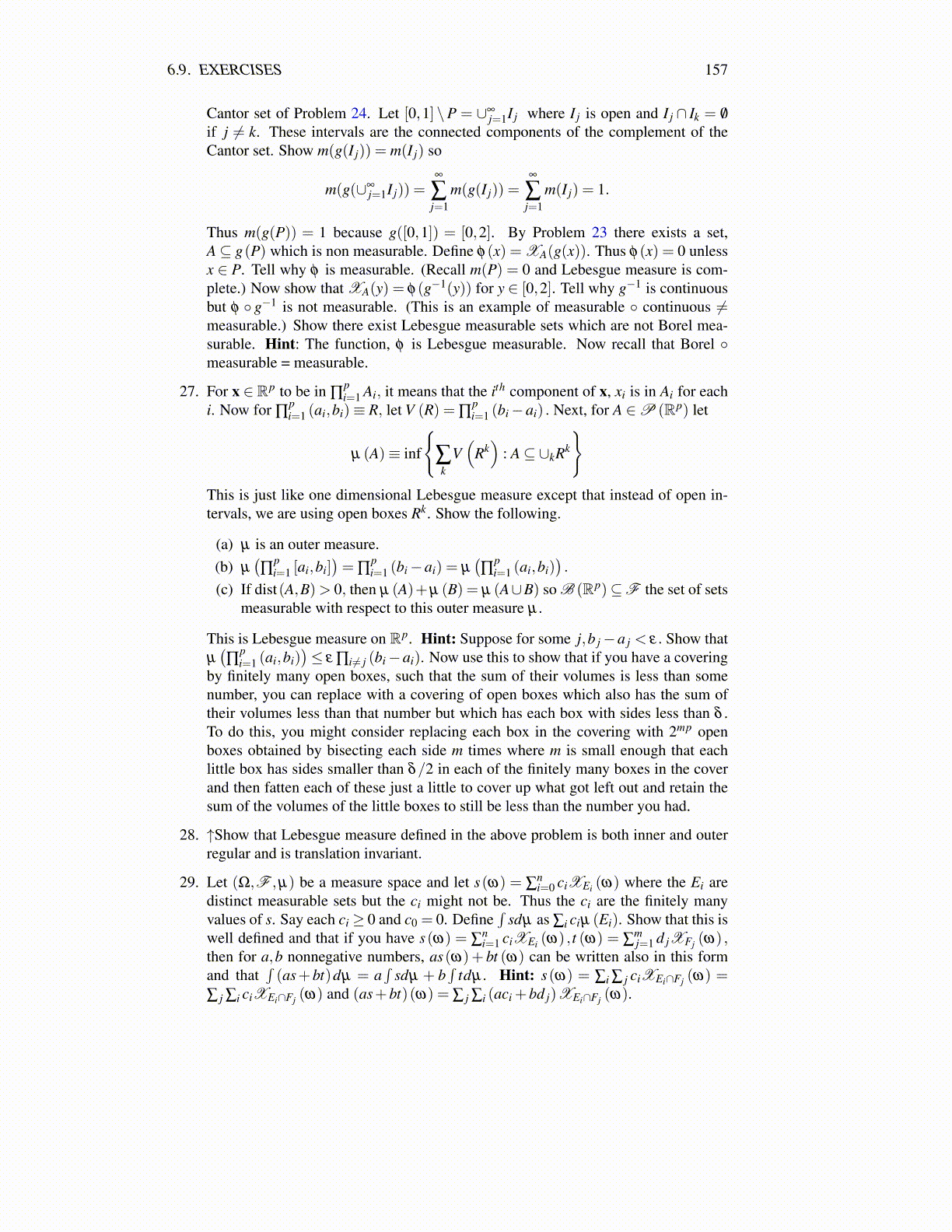
6.9. EXERCISES 157
Cantor set of Problem 24. Let [0,1] \P = ∪∞j=1I j where I j is open and I j ∩ Ik = /0
if j ̸= k. These intervals are the connected components of the complement of theCantor set. Show m(g(I j)) = m(I j) so
m(g(∪∞j=1I j)) =
∞
∑j=1
m(g(I j)) =∞
∑j=1
m(I j) = 1.
Thus m(g(P)) = 1 because g([0,1]) = [0,2]. By Problem 23 there exists a set,A⊆ g(P) which is non measurable. Define φ(x) = XA(g(x)). Thus φ(x) = 0 unlessx ∈ P. Tell why φ is measurable. (Recall m(P) = 0 and Lebesgue measure is com-plete.) Now show that XA(y) = φ(g−1(y)) for y ∈ [0,2]. Tell why g−1 is continuousbut φ ◦ g−1 is not measurable. (This is an example of measurable ◦ continuous ̸=measurable.) Show there exist Lebesgue measurable sets which are not Borel mea-surable. Hint: The function, φ is Lebesgue measurable. Now recall that Borel ◦measurable = measurable.
27. For x ∈ Rp to be in ∏pi=1 Ai, it means that the ith component of x, xi is in Ai for each
i. Now for ∏pi=1 (ai,bi)≡ R, let V (R) = ∏
pi=1 (bi−ai) . Next, for A ∈P (Rp) let
µ (A)≡ inf
{∑k
V(
Rk)
: A⊆ ∪kRk
}This is just like one dimensional Lebesgue measure except that instead of open in-tervals, we are using open boxes Rk. Show the following.
(a) µ is an outer measure.(b) µ
(∏
pi=1 [ai,bi]
)= ∏
pi=1 (bi−ai) = µ
(∏
pi=1 (ai,bi)
).
(c) If dist(A,B)> 0, then µ (A)+µ (B) = µ (A∪B) so B (Rp)⊆F the set of setsmeasurable with respect to this outer measure µ .
This is Lebesgue measure on Rp. Hint: Suppose for some j,b j−a j < ε. Show thatµ(∏
pi=1 (ai,bi)
)≤ ε ∏i ̸= j (bi−ai). Now use this to show that if you have a covering
by finitely many open boxes, such that the sum of their volumes is less than somenumber, you can replace with a covering of open boxes which also has the sum oftheir volumes less than that number but which has each box with sides less than δ .To do this, you might consider replacing each box in the covering with 2mp openboxes obtained by bisecting each side m times where m is small enough that eachlittle box has sides smaller than δ/2 in each of the finitely many boxes in the coverand then fatten each of these just a little to cover up what got left out and retain thesum of the volumes of the little boxes to still be less than the number you had.
28. ↑Show that Lebesgue measure defined in the above problem is both inner and outerregular and is translation invariant.
29. Let (Ω,F ,µ) be a measure space and let s(ω) = ∑ni=0 ciXEi (ω) where the Ei are
distinct measurable sets but the ci might not be. Thus the ci are the finitely manyvalues of s. Say each ci ≥ 0 and c0 = 0. Define
∫sdµ as ∑i ciµ (Ei). Show that this is
well defined and that if you have s(ω) = ∑ni=1 ciXEi (ω) , t (ω) = ∑
mj=1 d jXFj (ω) ,
then for a,b nonnegative numbers, as(ω)+ bt (ω) can be written also in this formand that
∫(as+bt)dµ = a
∫sdµ + b
∫tdµ . Hint: s(ω) = ∑i ∑ j ciXEi∩Fj (ω) =
∑ j ∑i ciXEi∩Fj (ω) and (as+bt)(ω) = ∑ j ∑i (aci +bd j)XEi∩Fj (ω).